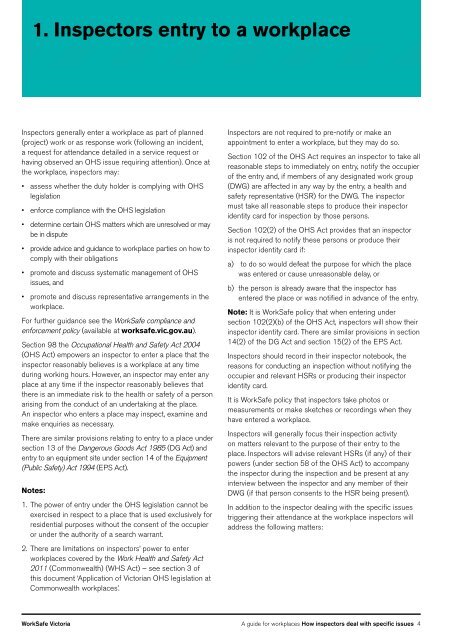How inspectors deal with specific issues
2d5GjDt
2d5GjDt
You also want an ePaper? Increase the reach of your titles
YUMPU automatically turns print PDFs into web optimized ePapers that Google loves.
1. Inspectors entry to a workplace <br />
Inspectors generally enter a workplace as part of planned<br />
(project) work or as response work (following an incident,<br />
a request for attendance detailed in a service request or<br />
having observed an OHS issue requiring attention). Once at<br />
the workplace, <strong>inspectors</strong> may:<br />
• assess whether the duty holder is complying <strong>with</strong> OHS<br />
legislation<br />
• enforce compliance <strong>with</strong> the OHS legislation<br />
• determine certain OHS matters which are unresolved or may<br />
be in dispute<br />
• provide advice and guidance to workplace parties on how to<br />
comply <strong>with</strong> their obligations<br />
• promote and discuss systematic management of OHS<br />
<strong>issues</strong>, and<br />
• promote and discuss representative arrangements in the<br />
workplace.<br />
For further guidance see the WorkSafe compliance and<br />
enforcement policy (available at worksafe.vic.gov.au).<br />
Section 98 the Occupational Health and Safety Act 2004<br />
(OHS Act) empowers an inspector to enter a place that the<br />
inspector reasonably believes is a workplace at any time<br />
during working hours. <strong>How</strong>ever, an inspector may enter any<br />
place at any time if the inspector reasonably believes that<br />
there is an immediate risk to the health or safety of a person<br />
arising from the conduct of an undertaking at the place.<br />
An inspector who enters a place may inspect, examine and<br />
make enquiries as necessary.<br />
There are similar provisions relating to entry to a place under<br />
section 13 of the Dangerous Goods Act 1985 (DG Act) and<br />
entry to an equipment site under section 14 of the Equipment<br />
(Public Safety) Act 1994 (EPS Act).<br />
Notes:<br />
1. The power of entry under the OHS legislation cannot be<br />
exercised in respect to a place that is used exclusively for<br />
residential purposes <strong>with</strong>out the consent of the occupier<br />
or under the authority of a search warrant.<br />
2. There are limitations on <strong>inspectors</strong>’ power to enter<br />
workplaces covered by the Work Health and Safety Act<br />
2011 (Commonwealth) (WHS Act) – see section 3 of<br />
this document ‘Application of Victorian OHS legislation at<br />
Commonwealth workplaces’.<br />
Inspectors are not required to pre-notify or make an<br />
appointment to enter a workplace, but they may do so.<br />
Section 102 of the OHS Act requires an inspector to take all<br />
reasonable steps to immediately on entry, notify the occupier<br />
of the entry and, if members of any designated work group<br />
(DWG) are affected in any way by the entry, a health and<br />
safety representative (HSR) for the DWG. The inspector<br />
must take all reasonable steps to produce their inspector<br />
identity card for inspection by those persons.<br />
Section 102(2) of the OHS Act provides that an inspector<br />
is not required to notify these persons or produce their<br />
inspector identity card if:<br />
a) to do so would defeat the purpose for which the place<br />
was entered or cause unreasonable delay, or<br />
b) the person is already aware that the inspector has<br />
entered the place or was notified in advance of the entry.<br />
Note: It is WorkSafe policy that when entering under<br />
section 102(2)(b) of the OHS Act, <strong>inspectors</strong> will show their<br />
inspector identity card. There are similar provisions in section<br />
14(2) of the DG Act and section 15(2) of the EPS Act.<br />
Inspectors should record in their inspector notebook, the<br />
reasons for conducting an inspection <strong>with</strong>out notifying the<br />
occupier and relevant HSRs or producing their inspector<br />
identity card.<br />
It is WorkSafe policy that <strong>inspectors</strong> take photos or<br />
measurements or make sketches or recordings when they<br />
have entered a workplace.<br />
Inspectors will generally focus their inspection activity<br />
on matters relevant to the purpose of their entry to the<br />
place. Inspectors will advise relevant HSRs (if any) of their<br />
powers (under section 58 of the OHS Act) to accompany<br />
the inspector during the inspection and be present at any<br />
interview between the inspector and any member of their<br />
DWG (if that person consents to the HSR being present).<br />
In addition to the inspector <strong>deal</strong>ing <strong>with</strong> the <strong>specific</strong> <strong>issues</strong><br />
triggering their attendance at the workplace <strong>inspectors</strong> will<br />
address the following matters:<br />
WorkSafe Victoria A guide for workplaces <strong>How</strong> <strong>inspectors</strong> <strong>deal</strong> <strong>with</strong> <strong>specific</strong> <strong>issues</strong> 4


